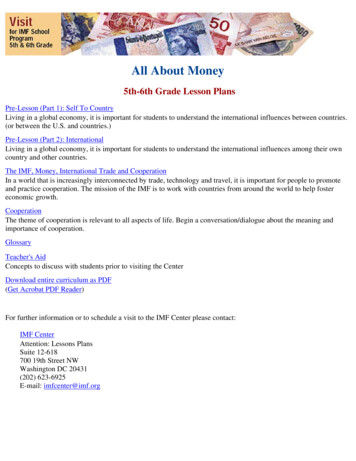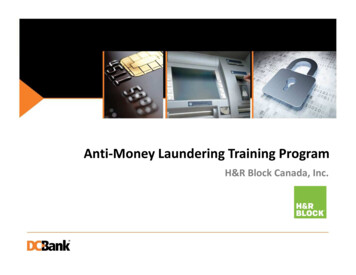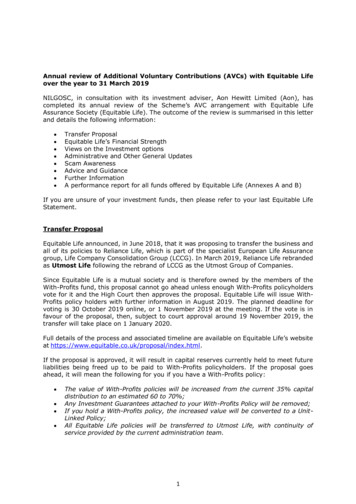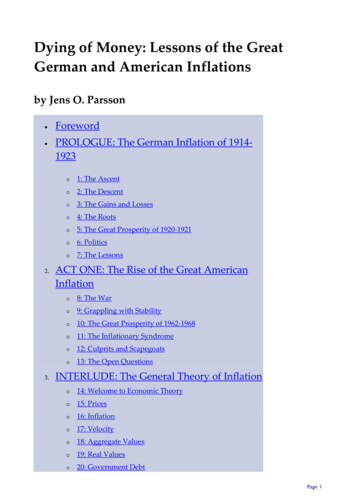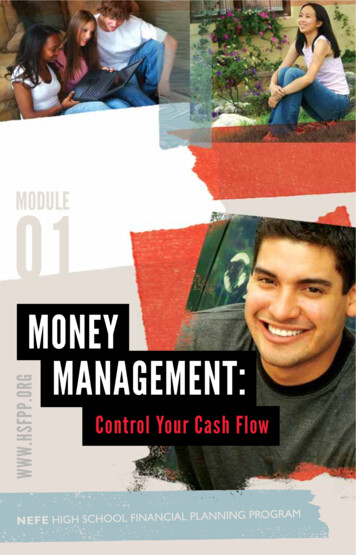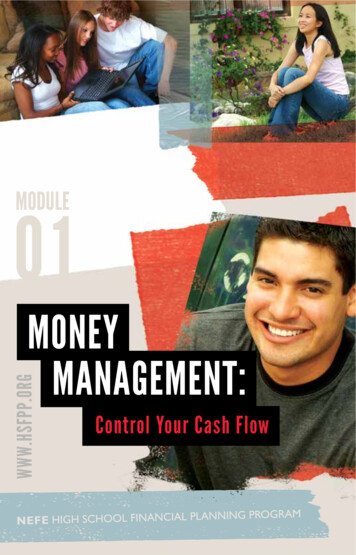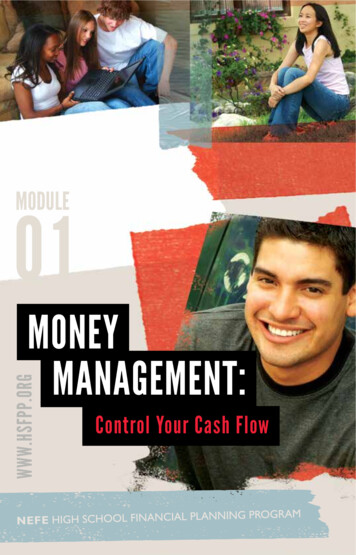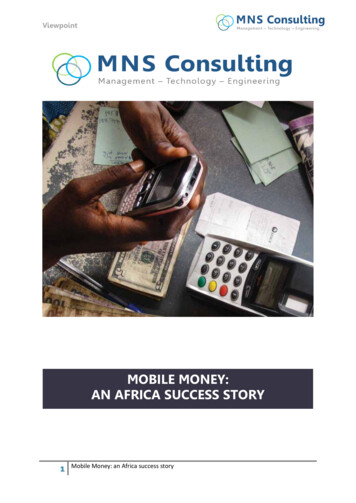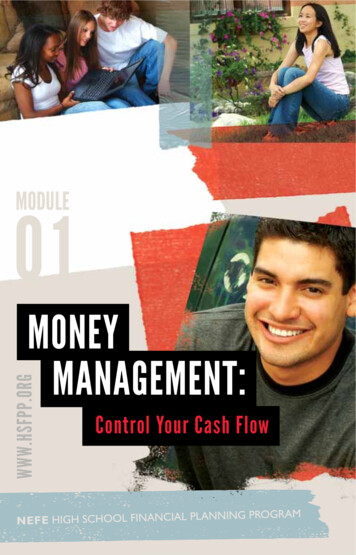
Transcription
Module01MoneyManagement:Control Your Cash Flow
About the NEFE High School Financial Planning Program SeriesBy picking up this booklet, you are on your way to making your dreams cometrue and headed down the path to financial independence. This program seriesincludes six topic modules to introduce you to the fundamentals of mindfulmoney management behaviors. Use what you learn in each module todevelop sensible habits to confidently manage your money and adapt tounexpected events.Program Modules1. Money Management: Control Your Cash Flow: goal setting –decision making – spending plan & budget – money management tips2. Borrowing: Use—Don’t Abuse: application process – loans –credit cards – costs – credit score – debt – rights & responsibilities3. Earning Power: More Than a Paycheck: earning potential –career plan – life stages – employee benefits – take-home pay – lifestyle4. Investing: Money Working for You: savings – investing – goals –options – risks & rewards – time value of money – diversification – plan5. Financial Services: Care for Your Cash: account types – fees –service options – transaction tracking – automation – identity protection6. Insurance: Protect What You Have: risk management – costs –claims – insurance types – coverage decisions – insurability factorsFind more money management tips and resources at www.hsfpp.org. 2012, National Endowment for Financial Education (NEFE ). All rights reserved.This publication may only be used for instructional and educational purposes as part of the NEFE High SchoolFinancial Planning Program (HSFPP). No part of this publication may be copied, reproduced, modified, orcombined with other material. This publication may not be used for any commercial purpose, and no separate fee orconsideration may be charged in exchange for this publication or for participation in the NEFE HSFPP.NEFE provides the HSFPP as a public service to enhance the financial literacy of youth. The program does notpromote financial products, financial planning organizations, individuals, or companies. However, to be effectivelytaught, the program often makes use of outside volunteer financial services professionals to add value in a classroomor similar setting. While providing this service, outside financial services professionals are not permitted to sell,advertise, or otherwise in any way promote the particular financial services organizations or products with which theymay be affiliated.
Module01MoneyManagement:Control Your Cash Flow
Table of ContentsMeet Michael and Selena / page 3MAKE OVER YOUR MONEY HABITS / page 4SCORE WITH GOALS / page 13DECIDE TO SUCCEED / page 19PLAN FOR VICTORY / page 22CRUISE TO THE FINISH LINE / page 322MON EY M A NA G EM ENT : C ontrol You r C as h F low
Use the tips and strategies in this guide to do the following:»» Explore how spending, saving, and values impact your finances.»» Set SMART money goals.»» DECIDE to make better money choices.»» Create a spending plan to reach your goals.»» Figure out ways to maintain a positive cash flow.Meet Michael and SelenaMichael lives with his mom andtwo sisters. Since his mom’swork hours were cut a fewmonths ago, he’s pretty muchbeen on his own moneywise.He worked two jobs lastsummer to pay cash for areliable used car, so he doesn’thave a car payment. He’s backto only one job now that schoolhas started again, and he’sstruggling to cover his expensesplus save for college, which hehopes to enter next year.Selena’s a freshman who liveswith her parents, has a brotherin college, and doesn’t worrymuch about money. She loves to shop with her friends, and she earns a littlemoney from occasional baby-sitting and pet-sitting jobs. But she mostly relies on“the bank of mom and dad” to get money as she needs it.To lear n m ore, vis it www.hs fp p .org3
Michael and Selena are going to join us as we talk about money, money, money—how to make the most of your dollars so you can avoid financial stress and getmore of what you want out of life.You’re lucky. The adults in your life didn’t have guides like this one back when theywere in school, and they can probably tell you about some major money blundersthey’ve made (and would love to forget!). So, master the lessons here and you’llget a head start on being in charge of your money and your life.MAKE OVER YOUR MONEY HABITSHabits can help you soar to success—or keep you panting on the treadmill,with success always out of reach.They’re sneaky, too. Because habitsare automatic, they kick in before youcan stop to think about how they’regoing to help you or hurt you in thelong run.4MON EY M A NA G EM ENT : C ontrol You r C as h F low“Successful peopleare simply those withsuccess habits. Author Brian Tracy”
Activity 1.1a: My Money HabitsWhat money habits do you have? List your money habits. Mark them as sensible( ), unwise (–), or neutral (N). We’ll come back to finish the right-hand column inthis chart later.Habit /–/NPossible ImpactStopping for fast foodon the way home everydaySince I could wait to eat untilI get home, that money could beused for other, more importantthingsPutting spare change in ajar every nightI can use it to buy something Iwant in a few monthsRight now, your money habits may not seem like a big deal. But habits can stickto you like glue. Good habits help you have self control as you plan to achieveyour goals. But bad habits may push you out of the driver’s seat and lead yousomewhere you really don’t want to go. The closer you get to being out on yourown, the more you need to be in control of your actions. For that reason, the timeto take on good money habits is NOW.By doing so, you also will find it easier to afford the things you really want today!To lear n m ore, vis it www.hs fp p .org5
Did You Know?There is a commonly held belief that if you do something for 21 days, it willbecome a habit. Applying a sensible money management behavior canbecome a habit for you in as little as three weeks!Neither Michael nor Selena uses a plan to manage money. So, to begin theprocess, they make a list of what they see as their own good and bad moneyhabits, as shown in the following table:Michael’s HabitsSelena’s Habits– – I buy fast foodafter schoolevery day.I pay bills assoon as I getthem.I buy icedcoffees afterschool every day.I comparisonshop whenbuyingnon-clothesitems.I buy a coupleDVDs with eachpaycheck.I regularlyverify myaccount activity.My shopping planis to just “buywhat I love.”I give 2 atchurch everyweek.Do any of their habits sound familiar to you?The problem with unwise habits is the short- and long-term impact they haveon your life. Say you’re Selena and you spend 3 on iced coffees after schoolevery day. Assuming you skip them on the weekends, that’s 15 a week ondrinks. OK, that’s not horrible, right? But what does that add up to in a month? In a school year? And what do you really have to show for all the money you spent? You could havespent that amount on clothes or a laptop!It’s not that spending money on iced coffees or fast food is necessarily bad. It’s OKto have things you enjoy in life. The question is, could you enjoy certain thingsless frequently to afford other things you’d enjoy in your life even more?6MON EY M A NA G EM ENT : C ontrol You r C as h F low
Activity 1.1b: My Money HabitsGo back to Activity 1.1a to look at your money habits. Think about how each habitcould affect you in the future. For each unwise habit you listed, write down asensible habit to replace it.Now, let’s solve a mystery The Case of theDisappearing DollarsEver open your wallet topay for something andrealize you were down toyour last dollar? You getflustered trying to figure out anotherway to pay and, in the meantime, yourbrain is racing to grasp “Where’d therest of my money go?” Bonus!Many teens find when theystop buying something out ofhabit and start buying it onlywhen they really want it, theyend up enjoying it more!The good news is that the thief will besuper easy to catch. Just look in themirror! Then remind yourself how even little expenses add up—fast.Of course, the only way to be sure of where your money goes is to track yourspending. So, put on your detective hat and start keeping what’s called aspending log. In it, you’ll record everything you spend money on and how muchyou spend each day. When you review the list, you can bet that your findings willbe an eye opener!To lear n m ore, vis it www.hs fp p .org7
Activity 1.2: My Disappearing DollarsHow much money did you spend in the past week? What did you buy?List what you spent money on in the past week (or month), and use theinformation to gather evidence in the case of Your Disappearing Dollars.Waiting is the Smartest MoveExcited about getting a raise, Michaelwent to get a new pair of soccer cleats.He spotted a jacket that looked goodon him and decided that because hewas now earning more at work, whynot buy it, too?A few days later, a friend remindedhim about concert tickets they weresupposed to buy the next day. Michaelhad totally forgotten, and now hedidn’t have the money. He couldn’twait until payday later in the weekbecause the concert was expected tosell out in hours. Bonus!If you’re diligent aboutkeeping it, your spending logwill reveal a lot about yourmoney habits—good andbad. It’ll also give you a wealthof clues about how to reachyour financial goals faster andmore effectively.As he was kicking himself for buying the jacket, he thought of his grandmother,who was always lecturing about the importance of waiting until you know youcan afford something (also known as delayed gratification).8MON EY M A NA G EM ENT : C ontrol You r C as h F low
Did You Know?Teens typically spend an averageof 18.50 a week.112011 Teens and Money Survey,Charles Schwab & Co. Inc.Waiting has always been a challengefor Michael. But now he saw herpoint. Waiting a week to buy thejacket would have been muchbetter than the situation he wasnow in—especially if he ended updisappointing his friend and missingthe concert.Like Michael, have you ever impulsively bought something, thenremembered you needed the money for something else?Waiting isn’t apunishment—it’s justsmart money sense.It gives you time to think throughyour purchase before you spendthe money. By taking the time tomake sure you really do want theitem, and will actually use (or wear)it, you then can buy with the peaceof mind of knowing that you won’tregret your purchase later.Did You Know?Fifty-seven percent of teens todayworry about not having enoughmoney.2 Are you one of them?2YouthPulse SM 2010, Harris InteractiveTo lear n m ore, vis it www.hs fp p .org9
Activity 1.3: Why Wait?There are benefits to waiting to buy something. Can you think of two or threereasons to hold off on a purchase?Reasons to Wait to Buy Something:If I don’t spend the money now, I’ll have money on hand if something moreimportant turns up.Do You Need It or Do You Want It?When Michael mentioned his dilemma to his mom, she asked if he needed thejacket. He said, “Kind of.” She replied, “You can’t ‘kind of’ need something, Michael.Either you do or you don’t. Which is it?”“Well, I do have a jacket, but it’s getting kind of ratty,” Michael said. His mom wentto the closet to get the old jacket. “This jacket is fine; all it needs is a wash,” shesaid. Michael admitted that she was right. He had wanted the new jacket, but hedidn’t need it.Like Michael, we all have a habit of saying we “need” things we really don’t. Needsare things that are essential to your health and security. You need food, water, aplace to live, clothes to wear—and money to pay for it all.Wants make life more interesting and fun, but you can get by without them.Everyone has wants, and that’s OK. But when money is tight, needs have tocome first.10MON EY M A NA G EM ENT : C ontrol You r C as h F low
The difference can be tricky sometimes. If Michael’s jacket really had been in badshape or no longer fit him, a new jacket would have been a need. But because thatwasn’t the case, the new jacket was a want.An item can be considered a need if it’s essential to getting a need. For example,you most likely don’t need transportation for your health or safety. But when youneed a job to pay for necessities like food and rent, and having a reliable way toget to work is required to keep that job, then transportation also becomes a need.Activity 1.4: My Needs and Wants:Can I Tell the Difference?Look at your spending log in Activity 1.2. Write down five things you spent moneyon. Then decide if each is a need or a want. The following list has been startedfor you:ItemNeed?Want?Jacket to replace one that is outgrownSecond jacket that looks good on youReview your list. Are you sure your needs are real needs? Do you think yourfriends or family would agree with your decisions? Are there times when yourwants may become a need?To lear n m ore, vis it www.hs fp p .org11
Valuing Your ValuesSometimes, the decision aboutwhether something is a need or awant depends on your values—theideas and beliefs that are mostimportant or most meaningful toyou. You probably don’t realize it,but all your thoughts, decisions, andactions reflect what you value andhow much you value it.Because many influences shapewhat we value, everyone’s set ofvalues is different. For example,financial security is a basic needeveryone has. But what that meansis different to each of us.Selena has financial security from her parents right now. When she needs money,they usually give it to her. She worries about what she’ll do when they stophelping her out. So, she’s decided she needs to save some money. Basically, thatsaved money is what it will take to make her feel financially secure so she can liveon her own after graduation.Michael’s steady part-time job helpshim feel more financially secure rightnow, although he still gets stressed outabout money. One of his top valuesis independence. He believes that ajob that pays twice as much as he’searning now would help him feelsecure enough that he wouldn’t needto rely on anyone else for money.12MON EY M A NA G EM ENT : C ontrol You r C as h F low
Activity 1.5: My ValuesWhat three or four things are most important to you?Why is each important to you?ValueWhy It’s ImportantSCORE WITH GOALSIf you were giving a birthday partyfor your friend, would you just throwit all together at the last minute? Ofcourse not!“Shoot for the moon.Even if you miss,you’ll land amongthe stars.”First, you’d have to get the OKs Musician Brian Littrellfrom her parents and your parents.Then, you’d need to decide whomto invite and send the invitationsfar enough ahead of time that theguests wouldn’t have made other plans. You also would have to figure out whatyou’ll serve to eat and drink, decide what you’re going to wear, and shop for food.And if you’re having the party at your house, you no doubt would clean the placebeforehand, too.In other words, you would decide on the goal (a great birthday party) and workbackward to figure out everything you’d need to do to make it happen.To lear n m ore, vis it www.hs fp p .org13
You should do exactly the same thing with your money. Many people spend,spend, spend, and then wonder why they don’t have enough money when it’stime to pay the bills or why they never have the money for the things they reallywant. If they had set clear goals, created plans to achieve them, and followedthe plans as faithfully as they watch their favorite TV shows, they’d be much lessstressed and a whole lot happier.The first critical step, though, is to figure out the desired end result.Fuel Your DreamsMoney can’t buy happiness, but it does play a big role in helping you to achievewhat’s most important to you. Here are a few examples of personal goals thatrequire money. Can you think of more?»» Attending prom»» Taking dance or guitar lessons»» Going to band or 4-H camp»» Going to college or a training school»» Getting a place of my own»» Getting married, with a fancy wedding»» Starting (and supporting) a family»» Saving the polar bearsBy figuring out what you need to make your personal goals a reality and settingfinancial goals to get you there, in no time you’ll be on your way to enjoyingthose things.Get SMART with GoalsSelena mentions to her older brother that she wants to save some money beforeshe graduates from high school. When he asks her how much, she doesn’t have asolid answer. When Michael tells a co-worker about needing to get new tires, he’sshocked to learn from her that a set of tires costs about 500.14MON EY M A NA G EM ENT : C ontrol You r C as h F low
Selena and Michael both realize it’s time to get SMART about their goals. Theyneed goals that are Specific, Measurable, Attainable, Relevant, and Time-bound.SMART Goals GuideSpecific»» What exactly needs to be accomplished?»» Who else will be involved?»» Where will this take place?»» Why do I want to accomplish the goal?Measurable»» How will I know I’ve succeeded?»» How much change needs to occur?»» How many accomplishments or actions will it take?Attainable»» Do I have, or can I get, the resources needed to achievethe goal?»» Is the goal a reasonable stretch for me? (neither out ofreach nor too easy)»» Are the actions I plan to take likely to bring success?Relevant»» Is this a worthwhile goal for me right now?»» Is it meaningful to me—or just something others thinkI should do?»» Would it delay or prevent me from achieving a moreimportant goal?»» Am I willing to commit to achieving this goal?Time-bound»» What is the deadline for reaching the goal?»» When do I need to take action?»» What can I do today?The SMART acronym is basically a checklist for creating turbocharged goals thatwill help guide you to success.To lear n m ore, vis it www.hs fp p .org15
After going through the questions, Selena decides on the following goal:To have 1,000 by August 1 of the summer after high school graduation so I don’thave to worry about money emergencies when I’m on my own. Starting today, I’llput 25 into my savings account every month until then.Michael does some research on what tires cost and sets his goal at saving 500 inthe next month. But then he realizes that it’s not a realistic goal, given what he’searning right now. So, he tries again and decides on the following goal:To transfer 40 from each weekly paycheck into my savings account over the nextthree months to have at least 500 set aside to buy new tires for my car.Satisfied, they start listing other goals they want to set. Help them make the goalsSMART in the activity that follows:Activity 1.6: SMART Goal MakeoverCreating SMART goals will help set you up for success. Can you tell what SMARTcriteria are missing from the goals below? Rewrite Michael’s and Selena’sstatements into SMART goals. Compare your changes with a classmate or theonline examples (www.hsfpp.org).GoalSelenaSave 200 for a tripto the outlet mallBuy a new MP3 playerMichaelSave money forcollege next yearBuy a new computerin January16MON EY M A NA G EM ENT : C ontrol You r C as h F lowSMART Goal
Are We There Yet?Deciding that you want something and buying it right away is called instantgratification. You saw how well that worked for Michael, though, when he boughtthe new jacket. You might even know from your own experience how buying onimpulse can get you into trouble.We usually classify goals into one of three categories, which you can see in thefollowing graphic:Goal Time SpanShort-, medium-, and long-termgoals are all delayed gratification.The only difference is how longyou delay. The further away yourgoal is, the more commitmentand patience it will take to reachit. Breaking up longer-term goalsinto shorter ones (like Selena’smonthly savings goal) can helpkeep you on track and motivatedalong the way.Goals Gut CheckAsk anyone in February how they’re doing on their New Year’s resolutions andyou’ll hear many people say that they did not follow through on their goals. Onereason is a lack of planning, which we’ll talk about later.Another reason is that the goal isn’t meaningful. If you don’t truly care about agoal, you’ll either ignore it or find yourself struggling to achieve it. Starting outyour goal statement with “I should ” is a major warning sign that it may not bemeaningful to you.“Should” goals often reflect other people’s values instead of your own. It’s OK ifyour goals aren’t the same as those of your family and friends. What matters is thatyour goals are important to you.To lear n m ore, vis it www.hs fp p .org17
Each time you create a goal, ask yourself thefollowing question:“On a scale of 1 (not at all) to 5 (extremely), how important isachieving this goal to me?”If you can’t rate a goal with at least a 3, think about whether that’s really a goal youneed to set for yourself.Always write down your goals and keep the listwhere you’ll see it often. This will remind you of whatyou’re working toward and keep you excited about it.Sometimes, a goal is a matter of personal responsibility. No one has ever saidthey’re excited about saving to pay their taxes. But millions of Americansput money aside every year for taxes because paying them is a citizen’sresponsibility—and they value staying out of trouble with the Internal RevenueSystem (IRS). If you’re stuck with a goal you’re not thrilled about, figure outwhat there is about that goal that is important to you. Then rewrite it to includethat feature.Reluctantly, Selena added a goal to her list, which you can see in the followingtable. Note the three possible reasons she might use to make the goal moremeaningful.Goal I’m NOT Excited AboutPaying the library for thebook I lost.What IS Important Is I’m feeling guilty and it’ll be a relief toclear my conscience.I can’t check out any more books untilI pay, and I have a term paper comingdue.I know my dad is just going to keepasking about it every week until I paywhat I owe.18MON EY M A NA G EM ENT : C ontrol You r C as h F low
Meaningful goals you’re excited about achieving: Now, that’s smart!Challenge 1-A: My SMART GoalsTake what you’ve learned about SMART goals and create two or three of your own.DECIDE TO SUCCEEDMaking decisions about moneycan be hard. Sometimes you haveto sacrifice what you want to havenow for what you really need—butcan’t have—until later. Sometimesthe best choice for you willdisappoint a friend. And if you’rein a relationship, your spendingpriorities might change so you putoff focusing on your own goals.There’s rarely a perfect solution.“The indispensable firststep to getting thethings you want out oflife is this: Decide whatyou want.” Economist Ben SteinAnd when you can’t count on a steady income stream, making decisions aboutmoney can be even harder.All you can do is make the best decision you can with the information you have atthe time.There’s a simple process to help you make the best possible decision. You may beusing it already, without even being aware of it. But once you knowingly put thatprocess into use, you’ll find it even easier to make better decisions.To lear n m ore, vis it www.hs fp p .org19
Let’s walk through the process using a fairly easy decision. It’s time for Selenato upgrade her cellphone. How does she DECIDE on upgrades? She fills out thefollowing chart:Action StepsSelena’s Results1. Define your goal. What do youwant to achieve?Upgrade to a new cellphonethis week and spend lessthan 100.2. Establish your criteria.What are the features you absolutelymust have? And which ones wouldyou like to have?It must be the same wirelessnetwork I use now and have acamera and slide-out keyboard.I want it to be blue. I wantto be able to download a lotof apps.3. Choose two to three goodoptions. Eliminate any optionswithout your must-haves andchoose a couple of the remainingoptions.After eliminating a bunch ofmodels, there are three I likethat either are blue or have alot of apps.4. Identify the pros and cons.If you have a lot of criteria andoptions, you may want to makea chart to quickly compare thefeatures of each option.The blue one has the fewestnumber of apps available, andI can’t change that. But Icould buy a blue case for it.Of the other two, the lessexpensive one actually hasbetter consumer ratings.5. Decide what’s best. Whichoption best matches your criteria?I’m going with the lessexpensive, higher-rated blackphone with a lot of apps!6. Evaluate the results. Afterward,note what you do and don’t likeabout your choice so you can addthat to your criteria for next time.Love it! (But next time, I’dreally love a blue one)20MON EY M A NA G EM ENT : C ontrol You r C as h F low
One decision will spark a chain of additional decisions to be made. For Selenaand her cellphone, the other decisions might include where to buy it and whichaccessories to get. For each new decision, you simply start the DECIDE process allover again.The Plot ThickensSelena’s decision was fairlyeasy because she was choosingbetween similar items.Economists call what you giveup the opportunity cost ofthe decision. For Selena, all shegave up was the phone’s color,which she realized she couldtake steps to fix. Decisionsare tougher when the choiceinvolves giving up something more important.Michael also needs a new cellphone. His carrier will give him a 50 credit toward anew model. If he wants a more expensive phone, he has to pay the difference. He’storn between an OK phone for 49 and the one he really wants, which costs 150.He has the cash because he just got 100 for his birthday. But he’d like to spendthat money on some new clothes. If he puts aside 25 every other week, it willtake two months for him to save up 100 for the more expensive phone.Should Michael buy the nicer cellphone or the new clothes? Or, arethere other alternatives?Challenge 1-B: My DecisionUse the DECIDE strategy for a decision you’re facing. You may want to ask yourfriends and family for their input—to make sure you consider everything! Goonline (www.hsfpp.org) to download a guide to help you DECIDE.To lear n m ore, vis it www.hs fp p .org21
PLAN FOR VICTORYYou’ve analyzed what you’ve beenspending money on and set someSMART goals to strive for.Your next step is to create the roadmap that will guide you to yourdestination: success.“In the words of Benjamin Franklin,By failing to prepare,you are preparingto fail.”Let’s avoid failure bypreparing the best route toreach your goals Your map is a spending plan or budget. It should detail exactly how you’regoing to use your money to pay for the things you want and need. An effectivespending plan not only multiplies your chances of success, it also helps make thejourney faster and easier.22MON EY M A NA G EM ENT : C ontrol You r C as h F low
WITHOUT a budget »» You have no idea if you’re getting closer to your goals—or even if it’s likely thatyou’ll ever reach them.»» You make random purchases of things you don’t really want or need.»» You end up kicking yourself when you don’t have money left for somethingimportant.»» You might end up going into debt. (We talk more about that inModule 2: Borrowing.)Budgets are not meant to be like a starvation diet for spending. In fact, if yourbudget is too restrictive, you’ll never stick with it. So, it’s best to create one thatbalances your desire to reach your goals with your desire to be satisfied with theride.Almost 60 percent of millionaires use a budget to manage their money.3Surprising? It shouldn’t be. You can’t get rich by mindlessly spending allyour money!A spending plan helps you manage your cash flow so you have the money topay for the things you need (and want). Managing your cash flow can be abalancing act. You either need to have enough money coming in to payfor everything, or you need to cut back on spending when yourcash is limited.The Millionaire Next Door: The Surprising Secrets of America’s Wealthy.T.J. Stanley and W.D. Danko. 19963To lear n m ore, vis it www.hs fp p .org23
Activity 1.7: My IncomeWhat kinds of income do you normally receive throughout the year? Are therecertain times when you seem to earn or get more money than usual? What aresome predictions you can make about your income this year based on whatyou’ve earned before?Balancing Act, ONE SIDE: IncomeThink of the money you receive, aka Income, as one side of a seesaw. Incomeconsists of any of the following:»» Paychecks from a job»» Your allowance»» Payment for odd jobs such as baby-sitting or yard work»» A gift card or cash for your birthday»» Social Security, disability, or unemployment benefits»» Proceeds from selling your stuff»» Interest earned on a savings accountIf you don’t have a job, your income may not be very steady right now. Even ifyou’re employed, your paycheck amount may vary if your hours change eachweek. That makes predicting your income harder, but not impossible.24MON EY M A NA G EM ENT : C ontrol You r C as h F low
Michael’s and Selena’s incomes during the school year are listed in the followingchart. As you can see, Michael regularly makes about 544 a month, while Selena’sincome fluctuates a lot more. She says she earns about 100 a month from heroccasional sitting jobs.Source of IncomePart-Time Job (net)*Baby-sitting, Pet-sittingMoney GiftsAllowanceEstimated Monthly Income**MichaelSelena 136 a week 0 0 100 a month 100 a year 250 a year 0 10–20 a week 544 160*Wages minus taxes and other required deductions**Not counting the gifts, which are received once or twice a yearBALANCING ACT, THE OTHER SIDE: EXPENSESNow let’s talk about the other side of the seesaw. Expenses are what you spendmoney on. Use your spending log to see what you have spent in the past topredict what you might spend in the future.Activity 1.8: My ExpensesUse your spending log fromActivity 1.2: My DisappearingDollars to group your expensesinto categories. Calculate whatpercent of your total spendingis used for each category.Create a pie chart that displaysyour spending visually.To lear n m ore, vis it www.hs fp p .org25
Expenses can be classified into thr
money management behaviors. Use what you learn in each module to develop sensible habits to confidently manage your money and adapt to unexpected events. Program Modules 1. Money ManageMent: Control your Cash Flow: goal setting - decision making - spending plan & budget - money management tips 2.
